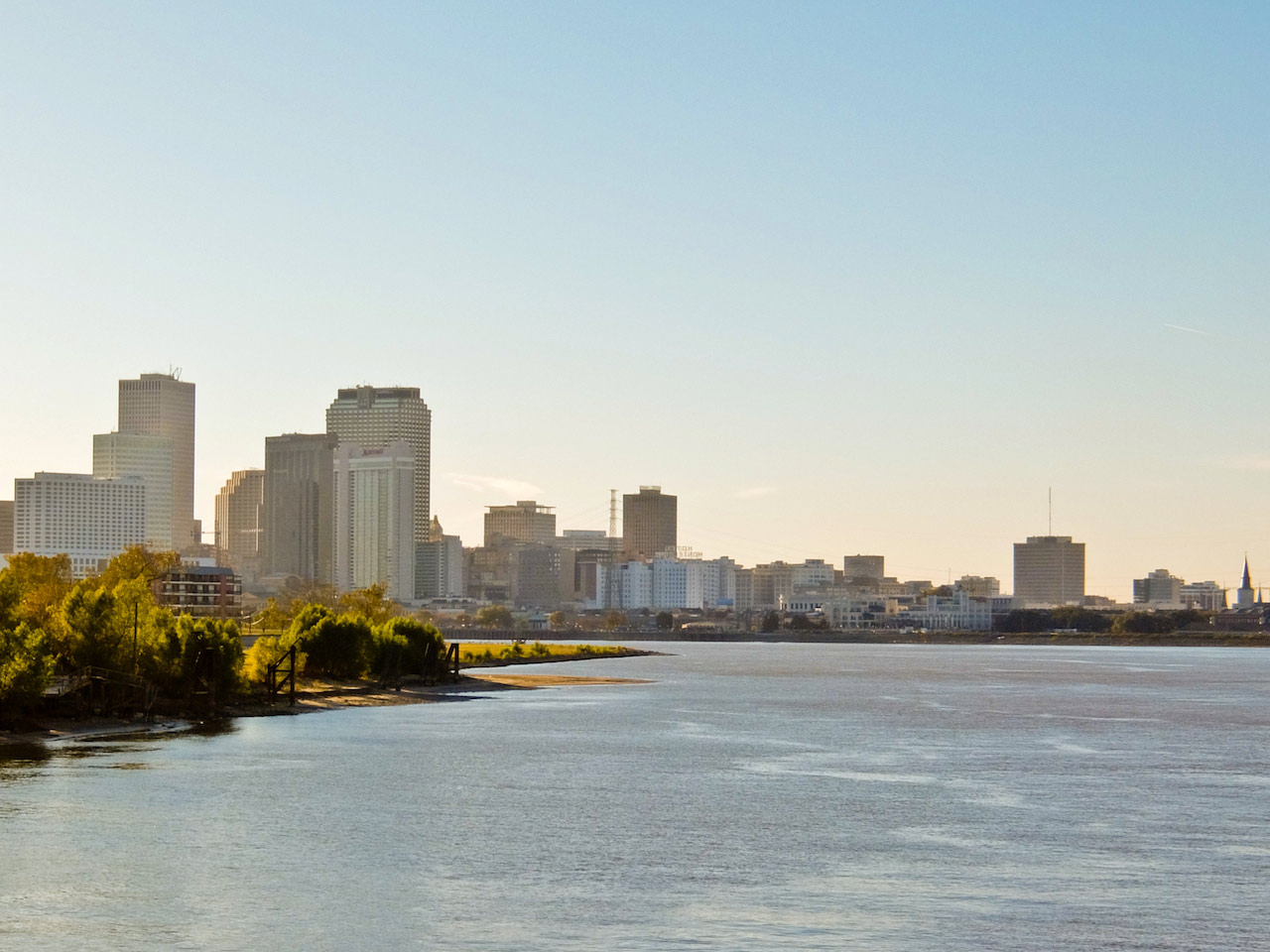After the horrors of Hurricane Katrina, New Orleans, or NOLA as it likes to be known, is definitely back on its feet. There’s a surge of new building and on my visit, they’re even resurfacing the historic Bourbon Street.
What I like about the city is that it’s easy to get around, either by walking, tram or even bus. Indeed you wouldn’t want a car here as parking charges in the French Quarter are exorbitant, even if you’re staying in a hotel. And you should definitely stay in the Quarter, in spite of the noise, as it’s definitely at the heart of things.
French Quarter Walking Tour
Although it’s perfectly easy to get around on your own, a guided walking tour is useful to get your bearings.
I meet my guide after a New Orleans breakfast of coffee and the famous beignets at Café du Monde. I’m right on the banks of the mighty Mississippi and get a brief introduction to the history of the first French settlement.
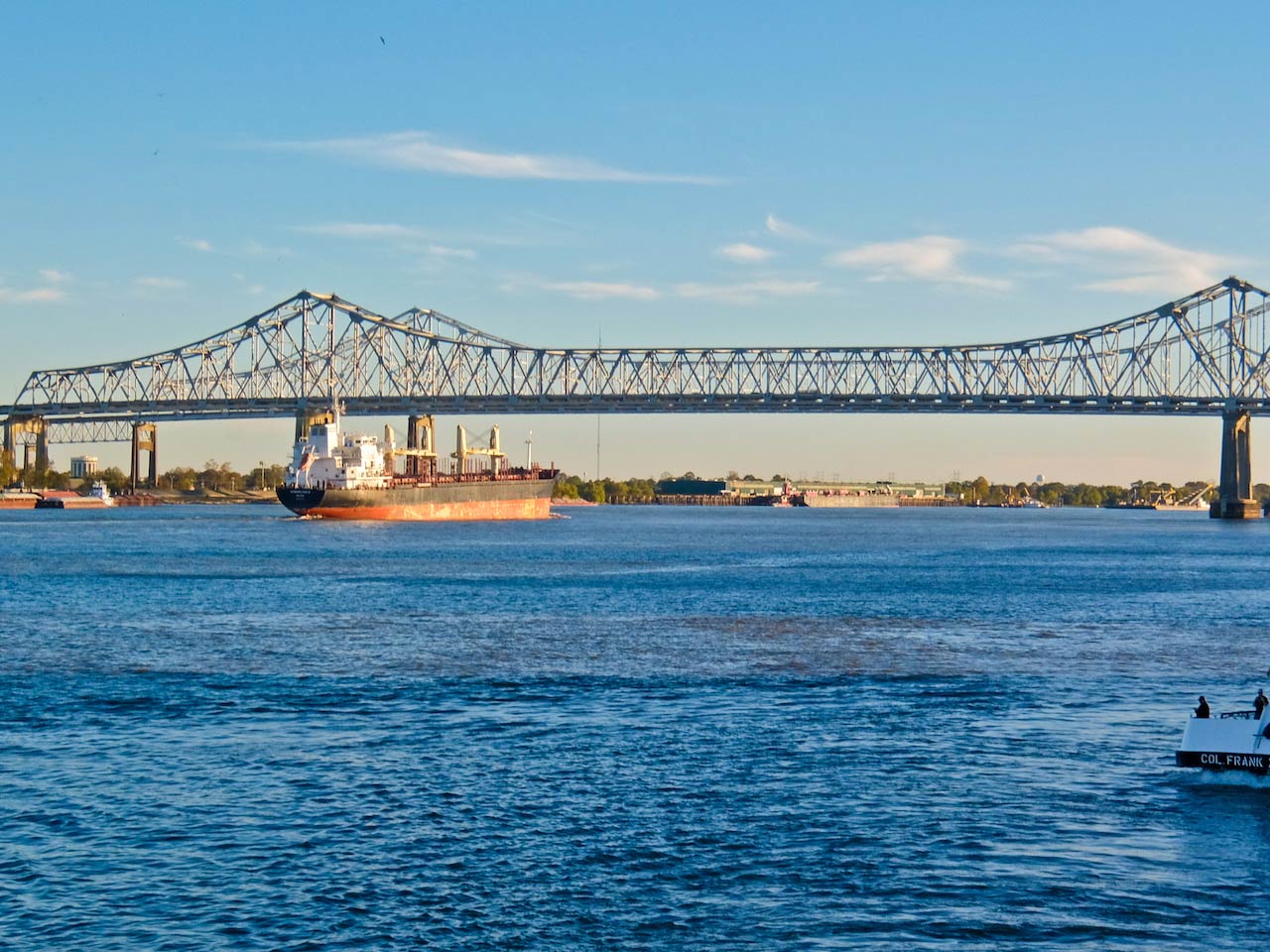
On the banks of the Mississippi River (c) Rupert Parker
It’s then a short walk to the French Market, which is an open-air area featuring shopping, dining and live music. There are five blocks of specialty retail shops featuring locally-made jewellery, clothing, cuisine and art. We then leave the banks of the Mississippi and pass the old Ursuline Convent, then turn into Royal Street. This has the archetypal French Quarter architecture, all cast iron balconies and baskets of flowers gracing the fronts of the houses.
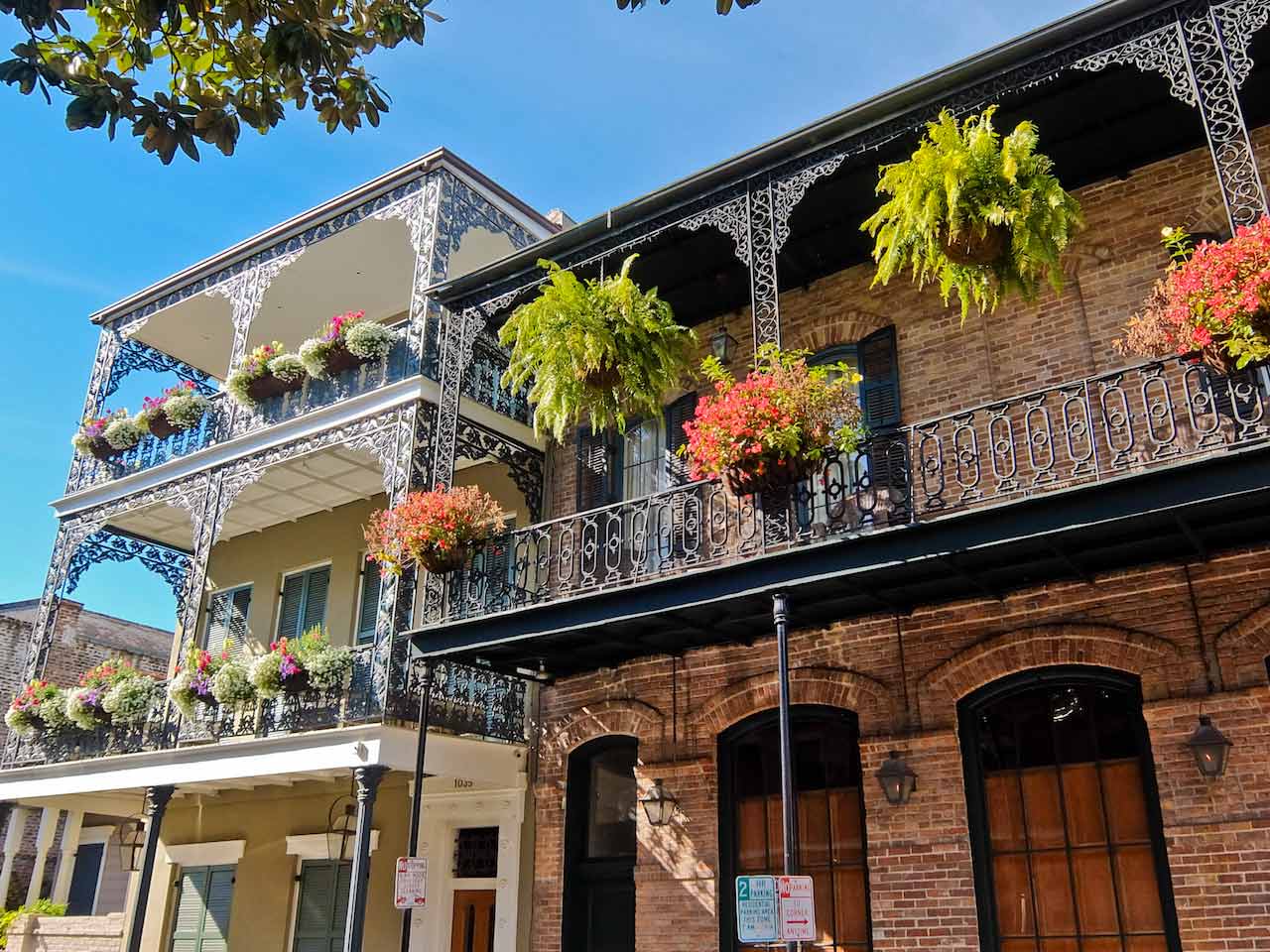
Royal Street – archetypal French Quarter architecture, with cast iron balconies and baskets of flowers (c) Rupert Parker
Further along, to the left, is the Avart Peretti House on St Peter Street where Tennessee Williams wrote Streetcar Named Desire. I emerge into Jackson Square in front of the iconic Andrew Jackson statue and the St. Louis Cathedral, the oldest cathedral still in use in North America.
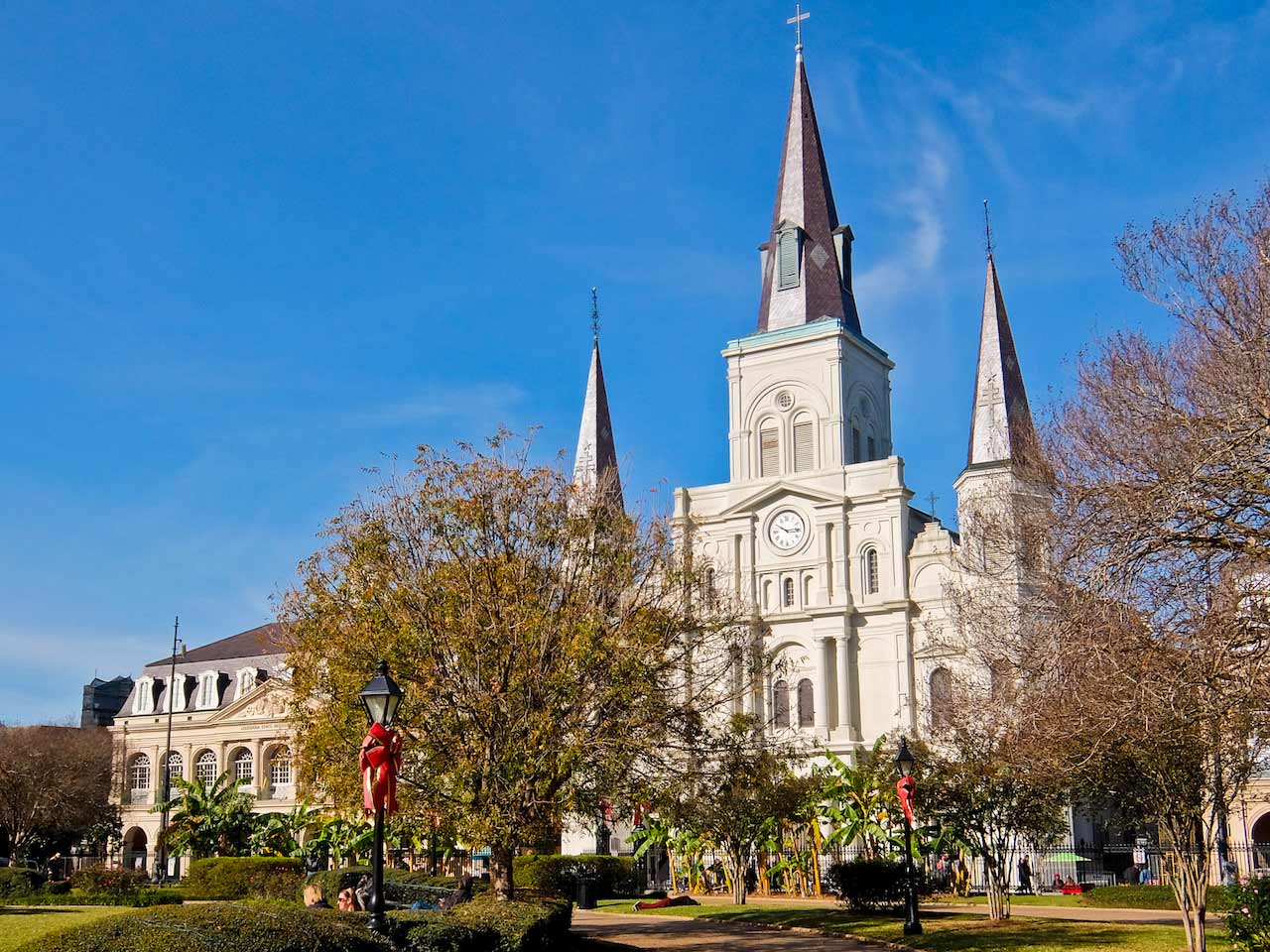
Jackson Square and the St. Louis Cathedral, the oldest cathedral still in use in North America (c) Rupert Parker
This is a noisy place with brass bands often competing against each other but it’s also the location of an open-air artist colony, where artists display their work on the outside of the iron fence. If you have the money you can have your portrait painted.
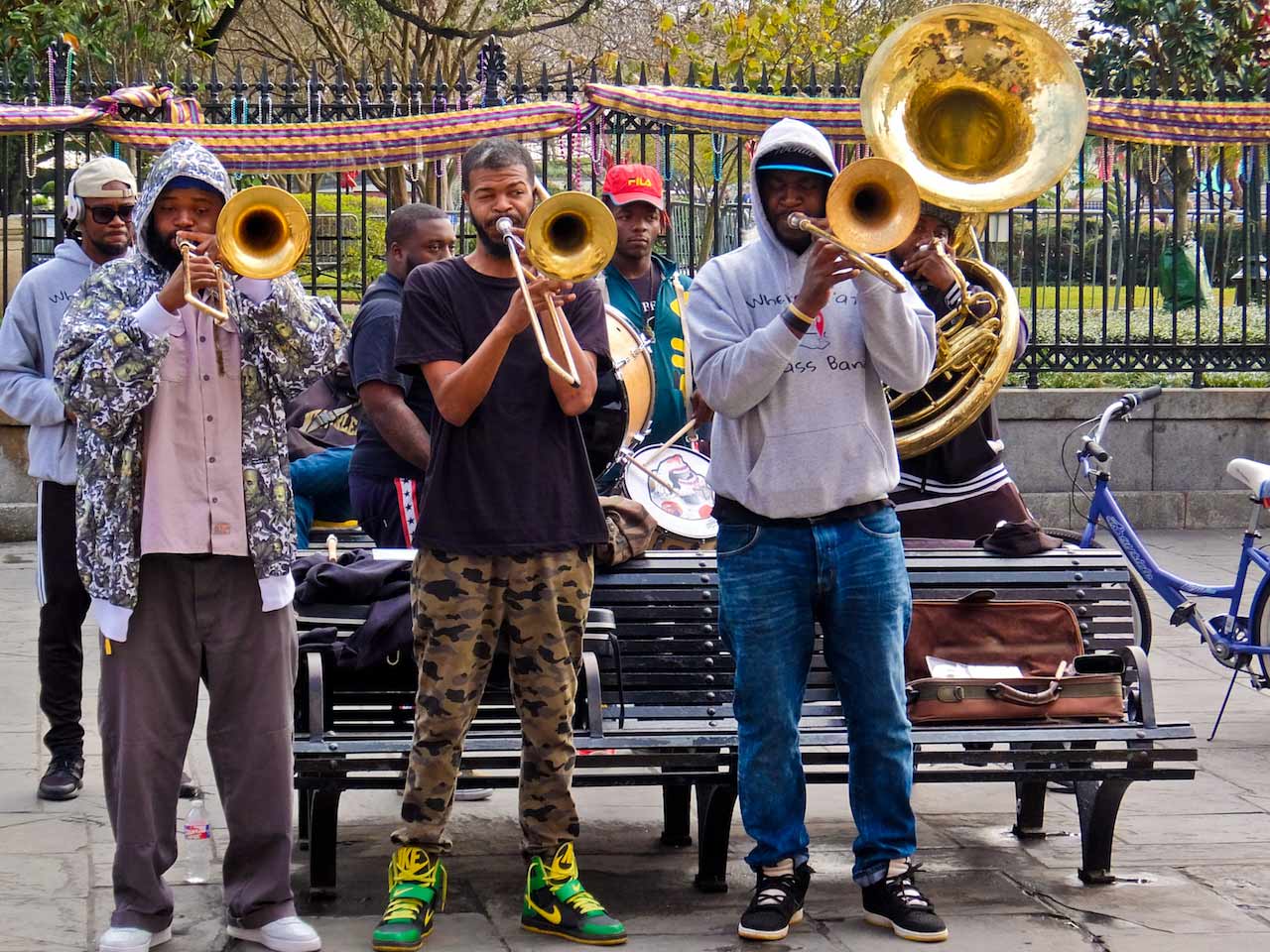
Brass band playing at Jackson Square (c) Rupert Parker
Over the course of a few days, I get to know my way around the quarter and find it at its most delightful in the morning before the crowds arrive. Later in the day, it’s still anarchic enough to avoid tourism chic – I love the bands who set up in the streets and just play. In the evening it gets too much and I prefer the Faubourg Marigny, the adjacent neighbourhood, where Frenchman Street is liked the old days of Bourbon Street – a strip of bars and restaurants with classy live jazz.
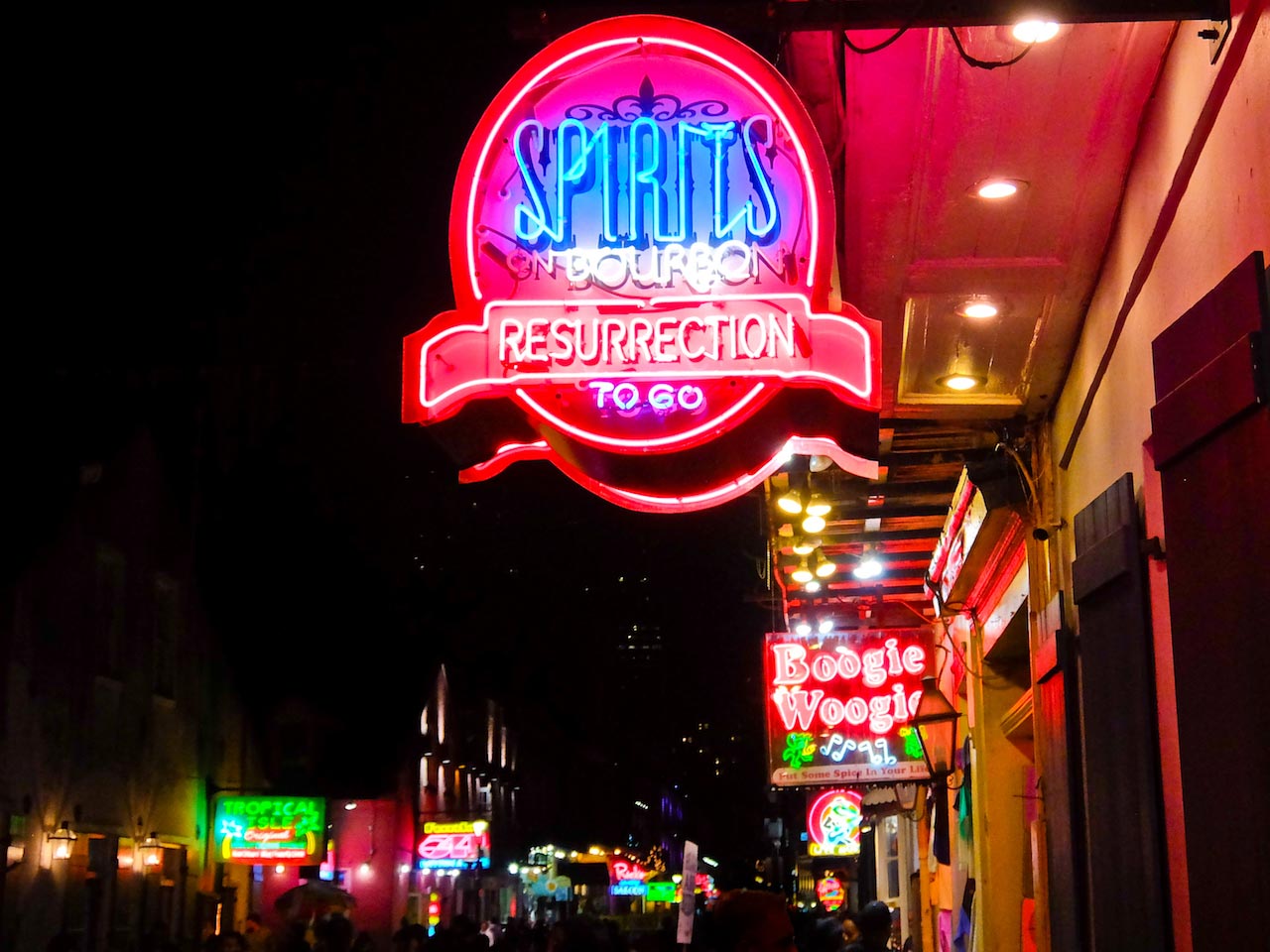
Bourbon Street – a strip of bars and restaurants with classy live jazz (c) Rupert Parker
Back in the quarter, you’re more likely to hear bands doing covers of rock and soul, but I do visit Preservation Hall one night. The place is pleasantly ramshackle with only a few chairs, but there’s standing room at the back, and four or more sets a night. The old guys have shuffled on to the great gig in the sky but the next generation are able players and know how to charm the crowd.
Jazz Cruise
Tempted by even more jazz, next day I make my way again to the banks of the Mississippi and climb aboard Steamer Natchez, the 9th paddle boat to bear the name. She was built in 1975 and is one of only two authentic steamboats on the river. There’s buffet-style dining and live jazz throughout the voyage. I take a seat on the upper deck at the front and enjoy the sights along the Mississippi, guided by an interesting commentary.
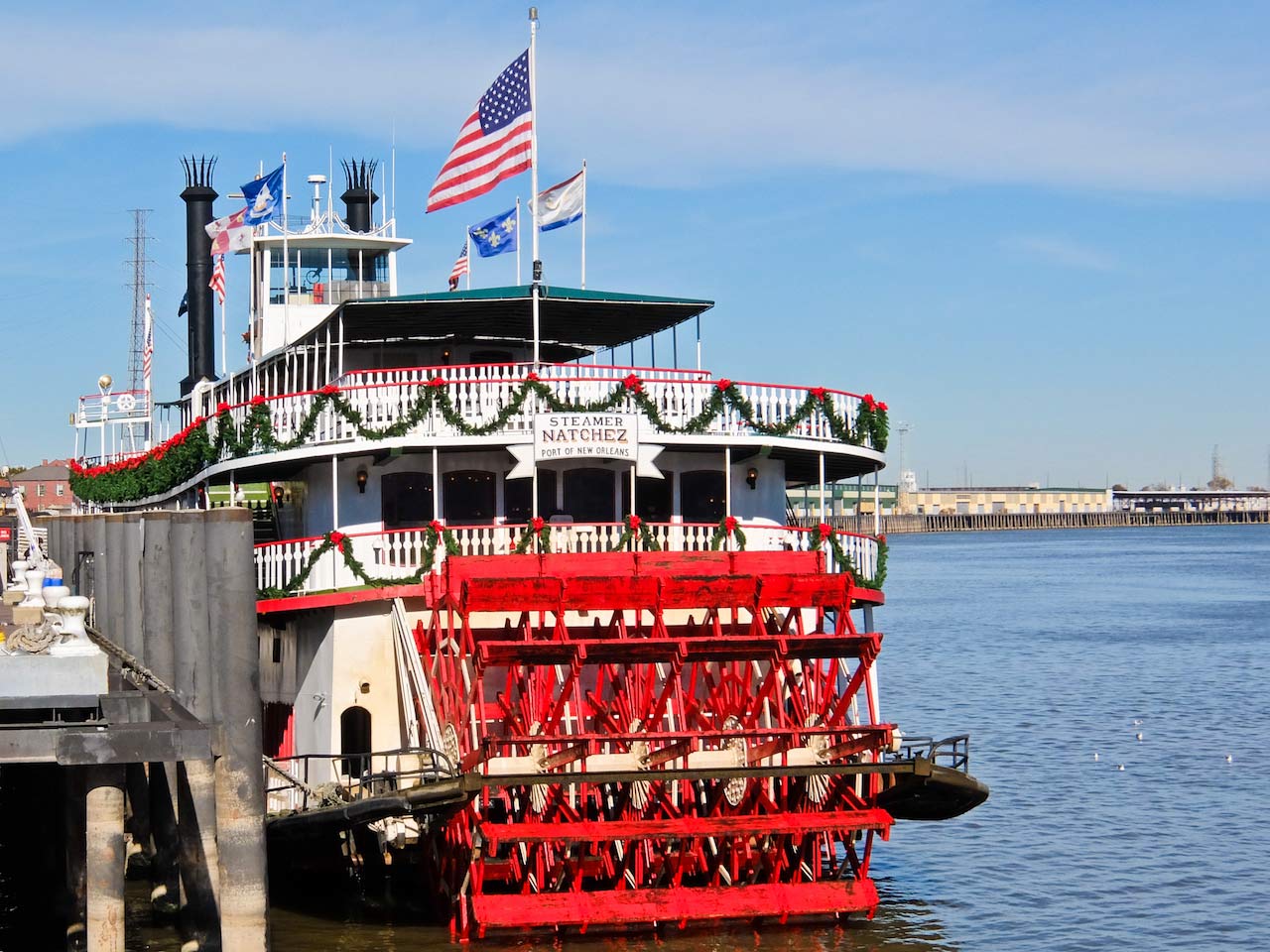
Steamer Natchez, one of only two authentic steamboats on the river (c) Rupert Parker
Warehouse/Arts District
Later, I cross Canal Street and make my way to the Warehouse District, a 19th century industrial area for storing grain, coffee and produce. When the port moved away, dereliction set in but it was revived by new galleries and museums. The mightiest of which is the National WW2 Museum, a massive hanger of a building, with state of the art interactive exhibits.
It was located in New Orleans because D-Day’s amphibious landing craft were designed and built in the city. Perhaps the most impressive exhibits are the WW2 planes, including a B17 Flying Fortress hanging from the ceiling. I also like the Final Mission: USS Tang Submarine Experience where you relive the last epic battle before it sank with most of its crew.
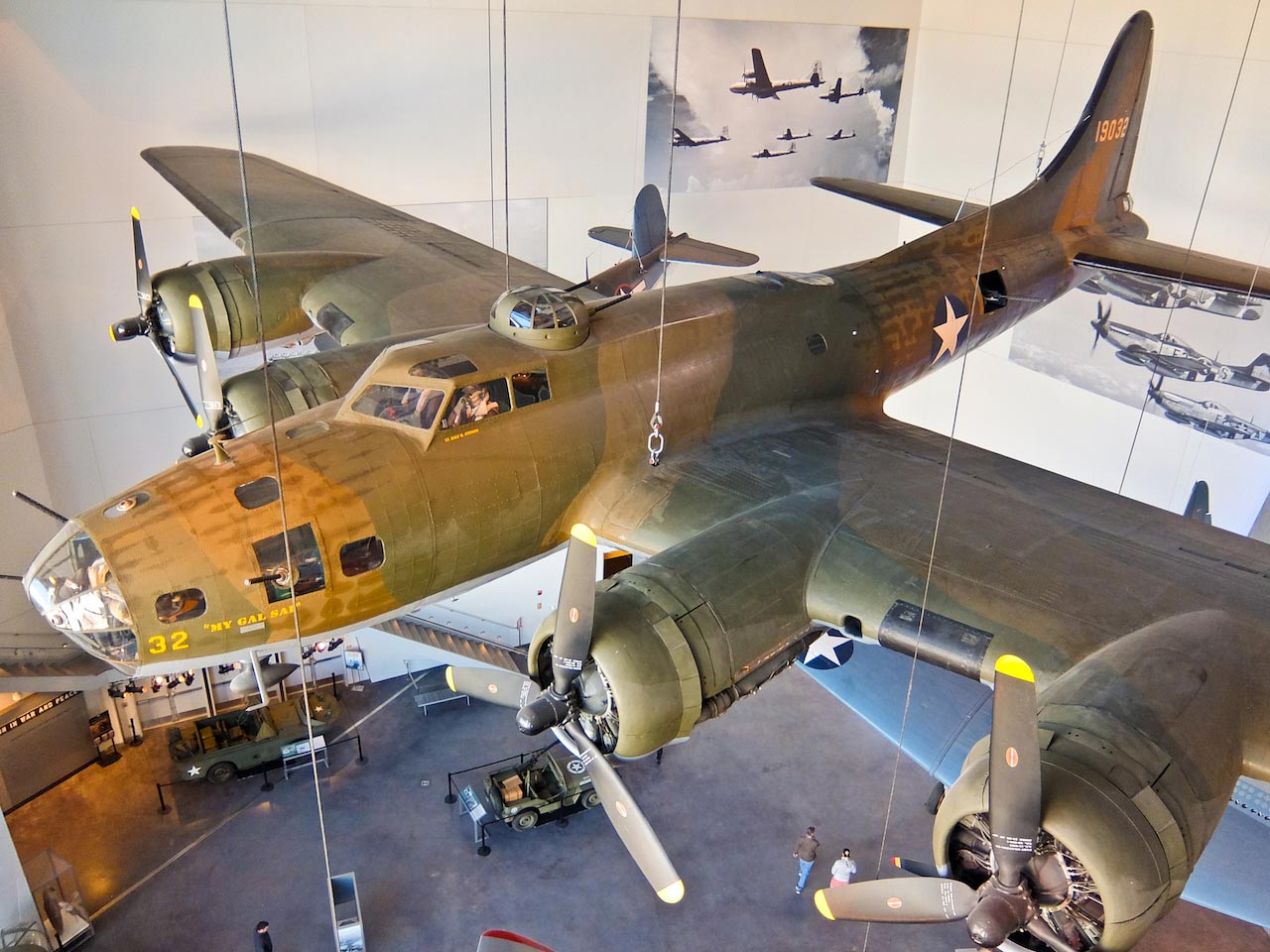
B17 at National WW2 Museum, New Orleans (c) Rupert Parker
The area was renamed the Arts District when the Contemporary Arts Center (CAC) opened in 1976. It’s a sprawling complex full of cutting edge-artwork and they stage an eclectic array of music, theatre and dance performances. I prefer the smaller Ogden Museum of Southern Art, nearby with a fine collection of artworks from the region. They also have live music every Thursday and I catch a fine performance from local bluesman Walter Wolfman Washington.
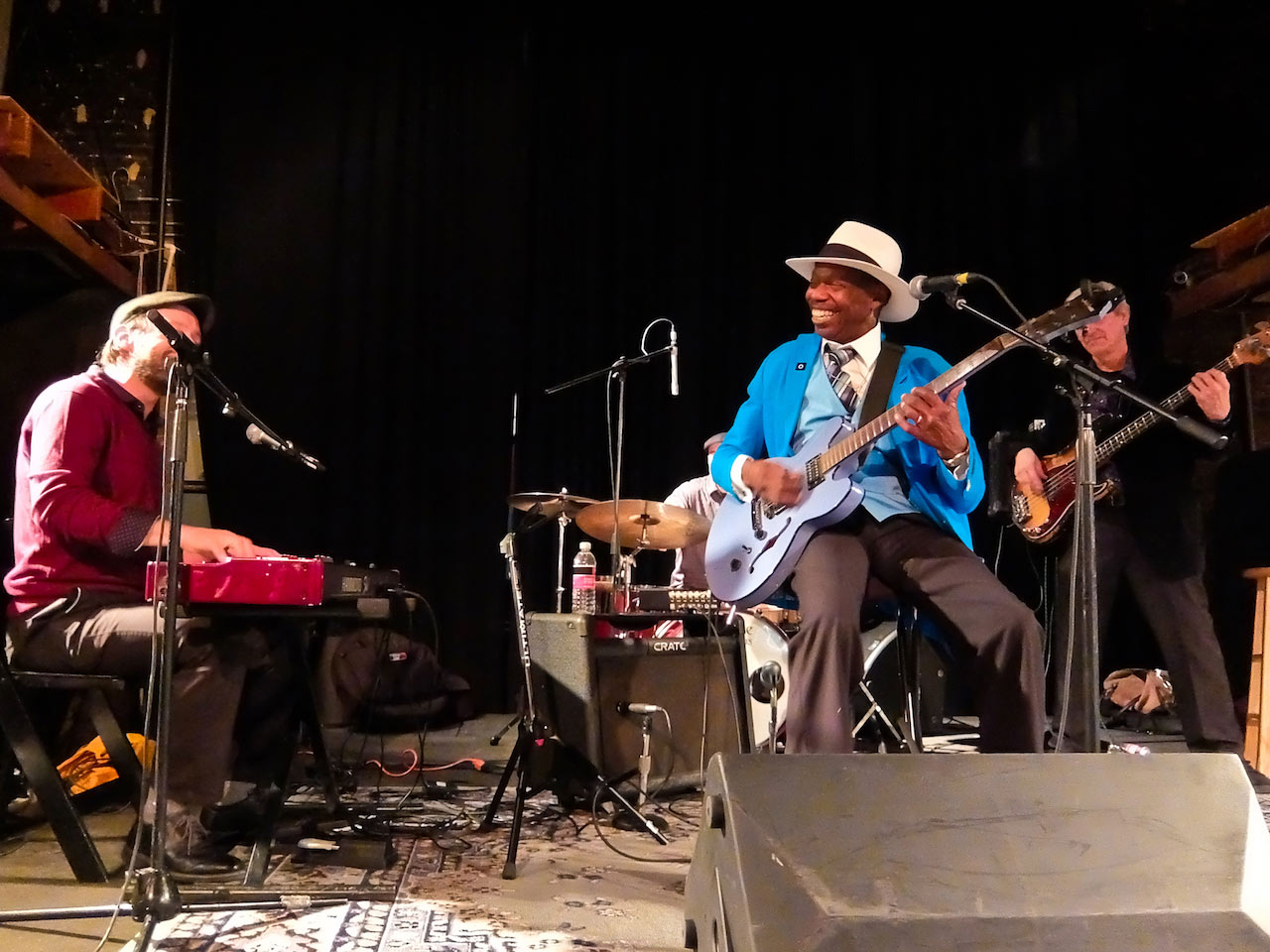
Walter Wolfman Washington (c) Rupert Parker
Uptown
On my last day, in true Tennessee Williams style I take the St. Charles Avenue streetcar through the Garden District uptown to the Carrollton-Riverbend neighbourhood. It’s not the fastest way to travel, or the most comfortable but I break it up by getting off and exploring Magazine Street. This follows the curve of the Mississippi, a few blocks north, for six miles and is crammed with antique stores, art galleries, craft shops and boutiques. Of course it also has some fine restaurants and bars.
Swamp Tour

Alligator on a log (c) Rupert Parker
One of the few reasons to leave New Orleans is to take a swamp boat trip into the Louisiana Swamps & Bayous. I’m here in December when the wildlife is not as abundant but we still manage to see alligators and a variety of birds including white egrets and herons. The tranquillity of nosing down the narrow channels, overhung with Spanish moss, is the real reason for coming here and the narrow draught of the swamp boat means we get to place others can’t reach.
Fact File
Hotels in French Quarter
The Hotel Maison de Ville is an 18th century house turned into a boutique hotel, the rooms are furnished with antiques and some even have balconies overlooking the street.
The Royal Sonesta Hotel is right on Bourbon Street with its 483 rooms newly renovated to the highest standard and its Jazz Playhouse presents live music every night.
Booking.com
Restaurants
Desire Oyster Bar is inside the Royal Sonesta Hotel and you’ll get the best local oysters raw or cooked whichever way you like them. They also do excellent Gumbo. French Quarter
Café du Monde was established in 1862 and has been serving its characteristic dark roasted Coffee and chicory with Beignets 24 hours a day, 7 days a week ever since. French Quarter.
Compere Lapin is where Chef Nina Compton, originally from St Lucia, adds a Caribbean twist to New Orleans cooking, coupled with French and Italian influences. I like her cold smoked tuna tartare with avocado and crispy plantains. Arts District
Toups South offers contemporary Cajun cuisine created by Chef Isaac Toups. Meat is his speciality and he does his own smoking. Try his smoked pork shoulder with watermelon, sweet peas, corn and charred pepper aioli. Arts District.
Bacchanal Wine Bar has a courtyard where you can enjoy live music, lunchtime and evening, with a fine selection of wines and food to match. Try their roasted cauliflower with crunchy chickpeas. Bywater.
Kenton’s Food & Bourbon offers over 150 whiskeys and Bourbon and smoke flavours their upscale American and Southern cooking. Their wood-fired oysters with smoked potato, country ham and a hint of chili are special. Uptown.
Brigtsen’s has been in this charming Victorian cottage for over 30 years. Chef Frank Brigtsen delivers a modern take on classic Creole/Acadian cooking and his wife runs the dining room. His Seafood Platter includes oysters, shrimp, scallops and drum fish. Riverbend.
Carrollton Market is a thoroughly modern Southern bistro where Chef Jason Goodenough stuns with simple yet sophisticated dishes. I like his seared Branzino with oyster stew. New Orleans Magazine Chef of the Year 2017. Carrolton.
How to get there
We flew direct from London to New Orleans with British Airways.
More information
New Orleans CVB has information about the city.
Louisiana Travel has information about the State.
Source : https://www.thetravelmagazine.net/new-orleans-five-days-travel-guide/

